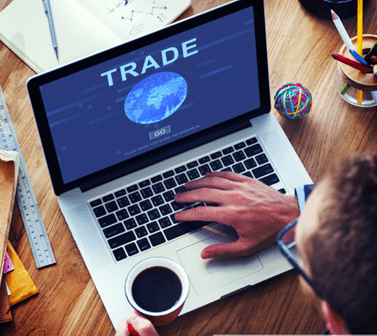Detailed Review of High Frequency Trading Algorithm | 2017 Guide | Algorithmic Trading (What Is Algo Trading)?
In today’s tech savvy society, our financial systems are continuously integrating technological solutions to increase efficiency.
A variety of new technologies have become highly popular and changed the pace of stock market trading. Algorithmic trading (also known as algo trading or a high frequency trading algorithm) has grown in popularity through market trading since the 1970’s.



Image Source: BigStock
Algorithmic trading is the process of using computerized systems to follow an algorithm, or a set of clearly defined instructions, to place trades in a market.
These trading algorithms follow a variety of specific criteria for selecting trades, and execute very large numbers of these trades at an astoundingly quick pace.
Essentially, algorithmic trading uses a set of rules to identify profitable trades and executes them at a high frequency. These computer systems allow firms to make trades in microseconds, often making thousands of trades in the blink of an eye.
See Also: Top Robo Advisors in Canada
What is Algorithmic Trading? Algo Trading Explained
Algorithmic trading is basically computerized market trading.
High frequency trading algorithms are widely used by pension funds, institutional traders, and mutual funds to break down large trades into smaller ones to minimize market impact and risk.
This section of the article seeks to answer the question, “What is algorithmic trading?” and explore how algo trading works so you can decide if this technology suits your financial needs.
There are a few steps an algorithmic trader must complete in order to take advantage of these trading innovations. Firstly, a trader needs to develop their trading criteria.
Trading algorithms look for signals and trends such as the movement of interest rates, economic changes, and other small financial patterns to capitalize on these changes early.
Their set of rules could be based upon price, timing, quantity, or other mathematical models. Investopedia offers a great example of simple algorithmic trading criteria:
- Sell stock when the 50-day moving average falls below the 200-day moving average
- Buy 50 shares of stock when the 50-day moving average rises above the 200-day moving average
The trader then needs to either create a computer program or use trading software that will automatically monitor the stock price and execute trade orders when the criteria of the trading algorithm are met. Most algo trading is completed using high frequency trading, meaning that traders try to place a large number of trades at rapid speeds across various markets.
Goals and Statistics Behind Algo Trading
The main goal of algorithmic trading and high frequency trading algorithms is to make large amounts of trades at lightning speed across multiple exchanges, while minimizing risk and creating liquidity in the market.
According to The Atlantic, algorithmic trading helps provide liquidity and lowers commissions, as well as affecting how markets function. Algo trading is designed to get the best possible price available while splitting large orders into smaller trades.
Firms using high frequency trading algorithms represent at least 73% of the U.S. equity trading volume.
Approximately 50% of stock trading volume in the U.S. is currently being generated through algo trading.
All-in-One Change Management Tools
Top Rated Toolkit for Change Managers.
Get Your Change Management Tool Today...
It is widely recognized that, although a significant component of market trading, algorithmic trading is trending quickly, and its effects on the economy are somewhat unclear.
The benefits of algorithmic trading include:
- Trades are ordered at the best possible time
- Optimal, programmed timing allows for orders at the best possible prices
- Low risk of manual error and automatic order placement
- Reduced risk of human error based on emotional/psychological factors
- Back testing can be used to test the trading algorithm based on historical data
- Automatic checks on market conditions
- Builds liquidity in markets
- Fast execution time
Don’t Miss: Schwab Intelligent Portfolios vs. FutureAdvisor – Rankings & Review
Development of Algorithmic Trading: The History of Algo Trading
There is a growing group of traders and programmers who have created tech start-ups and software programs to suit the needs of traders who utilize algorithmic trading. Although algorithmic trading has become increasingly popular in market trading, it is actually a process that has developed over time. Algorithmic trading software has become available to a growing number of individuals.
According to Duke Law, computerization of orders in the financial market began in the mid 1970’s through the New York Stock Exchange. Their Designated Order Turnaround (DOT) system allowed the electronic transmission of securities trades. Prior to this development, financial transactions and data were transmitted slowly using ticker tape.



Image Source: U.S. SEC
In 1971, NASDAQ became the first electronic stock market using electronic quotation. Later, in the 1990s, other trading networks evolved called electronic communications networks.
The Securities and Exchange Commission (SEC) authorized the existence of alternative trading systems.



Image Source: Nasdaq
Another factor that led to the development of algorithmic trading and high frequency trading algorithms occurred in 2001, when the stock exchanges began quoting prices in decimals rather than fractions.
The minimum stock tick size changed from 1/16th of a dollar to $0.01, leading to increased liquidity in trading. This allowed institutional traders to split up trades using algorithms to execute orders more quickly at the best prices.



The Dark Side of Algo Trading
There are a variety of challenges involved in the process and technology behind the use of algorithmic trading. One major challenge is that there is a lack of government and industry oversight over the trading algorithms, and often times, few mathematicians and programmers have a deep understanding of how they work.
Another challenge is the potential for security breaches and technology blunders.
There are several major disadvantages and challenging realities involved in algorithmic trading. Some of the disadvantages of using trading algorithms are:
- Technological issues
- Ongoing monitoring
- Overreliance on optimal algorithms
- Security concerns
Technological issues can plague the simplest programming systems. For example, a user could lose internet or network connectivity, experience power outages, and face hardware or software programming failures. Due to the nature of high frequency trading algorithms, this could mean misplacing or neglecting massive amounts of orders with major losses.
Related: TradeKingvs Scottrade – Rankings & Review
Monitoring, Optimizing, and Security in Algo Trading



Image Source: BigStock
Ongoing monitoring is important to insure the fidelity of trading algorithms. Some DIY algo traders tell stories of major losses because of a lack of monitoring in light of glitches and errors.
For example, one algo trader lost more than 60% of his trading portfolio when he updated his trading algorithm before going out of town: a simple bug in the system told his program to buy twice as much of everything it sold.
It is also possible for traders to rely too heavily on algorithmic trading optimization. Back testing can show that a trading algorithm works perfectly and profitably based on history and prior data. However, this information may not hold true in the live market in the future. It requires a balance of perfecting trading algorithms with knowledge of how the live market functions.
In addition, it seems that all new technologies are fallible, at some point, to security concerns and breaches; algorithmic trading is no stranger to security threats.
In July of 2009, Goldman Sachs’s algorithm for trading was stolen by a Russian immigrant. The alleged thief, Sergey Aleynikov, attempted to steal the trading system that Goldman Sachs uses to trade stocks and commodities.
Popular Article: TradeKing vs E-Trade – Rankings & Review









Algorithmic Trading Software
Previously, this article has focused on answering the question, “What is algorithmic trading?” and provided information about the general pros and cons to help you decide if algorithmic trading is a fit for your financial needs. For traders ready to start exploring algorithmic trading, there is a wide variety of algorithmic trading software available.
Because a great deal of money is invested into high frequency algorithmic trading, it is imperative that traders carefully scrutinize their software and programming choices. Quality software and programming can help minimize the chances of glitches or bugs that can cause drastic losses.
If you have trading and computer programming knowledge, it is possible to create your own algorithmic trading software. If not, ready-made software is offered by brokers or can be purchased from third-party providers.
Ready-Made Algorithmic Trading Software
When looking to purchase algorithmic trading software, there are a variety of key components to look for in a reliable platform. Algorithmic trading software should offer the following components:
- Real-time market data and pricing
- Access to a variety of markets
- Minimal time between transactions
- Back testing based on historical data
- Customization of programming options
- Access to broker networks or direct access to exchange
Quantopian: Algo Trading Software for Programmers
One popular online platform for algorithmic trading is Quantopian. This algorithmic trading software allows anyone with basic programming knowledge to create trading algorithms using a web browser. The startup was founded in 2011 by John Fawcett, making algo trading available to a wider audience.



Image Source: Quantopian
According to Forbes, Quantopian provides market data for traders to create a trading algorithm. The user writes the code on the website and can then back test the trading algorithm to determine if the code serves their needs. Algorithmic trading using Quantopian is private – other uses cannot access your trading algorithm. Quantopian requires users to have coding knowledge to create programming.
Interestingly, Fawcett stated that there is a relatively small number of people involved (10,000 people worldwide) who complete most of the algorithmic trading. His theory is that the small number of people in the market makes this an inherently dangerous way of operating market trading. Quantopian was created to make this programming available to an increased number of people interested in trading.
Free Wealth & Finance Software - Get Yours Now ►
Algo Trading – Is Algorithmic Trading Right for Me?
In this article, we have offered a wealth of information on algorithmic trading and methods of creating a high frequency trading algorithm. When considering if algo trading can meet your needs, it is important to consider your financial goals and abilities. It appears as though the algorithmic trading field is a promising opportunity for those with extensive trading knowledge and programming experience.
The impact of algorithmic trading on the economy is still unknown. It is not a new technological development, yet the increase in DIY algo trading has drawn many concerns in the financial industry. The potential for security breaches, technological failures, and potential amateur impact on the stock market creates the need to critically analyze the impact of algorithmic trading in the future.
AdvisoryHQ (AHQ) Disclaimer:
Reasonable efforts have been made by AdvisoryHQ to present accurate information, however all info is presented without warranty. Review AdvisoryHQ’s Terms for details. Also review each firm’s site for the most updated data, rates and info.
Note: Firms and products, including the one(s) reviewed above, may be AdvisoryHQ's affiliates. Click to view AdvisoryHQ's advertiser disclosures.





